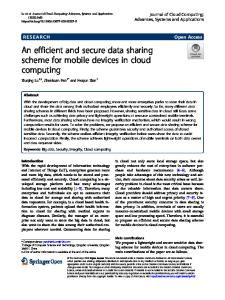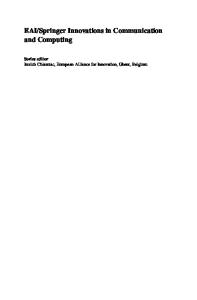A Community Assets Infrastructure for the Secure Use of Mobile Computing Devices in the Rural Health Landscape
The ubiquity of mobile computing devices in the workplace has created a vast landscape of opportunity in rural communities centered on the increased population access owing to the improved mobility. Healthcare workers are able to reach previously disconne
- PDF / 233,259 Bytes
- 11 Pages / 439.37 x 666.14 pts Page_size
- 95 Downloads / 203 Views
)
Nelson Mandela Metropolitan University, Port Elizabeth, South Africa {Kevin.Kativu,Dalenca.Pottas}@nmmu.ac.za
Abstract. The ubiquity of mobile computing devices in the workplace has created a vast landscape of opportunity in rural communities centered on the increased population access owing to the improved mobility. Healthcare workers are able to reach previously disconnected communities and homesteads to deliver health related services through the use of custom mobile computing devices or applications that facilitate the viewing, recording and updating of patient records. Notably, the presence of electronic patient information presents privacy and confidentiality challenges that if not addressed, may affect the delivery of health services thereby negatively impacting on the overall health outcomes of the communities. Deficit based solutions target the needs and challenges of the communities in developing solutions and have been widely used; however, little emphasis has been placed on utilizing the existing asset resources that contribute positively to the overall health outcomes in the development of solutions. This paper leverages off an asset model developed by Morgan and Ziglio to identify existing community assets in a rural community through the use of a survey issued to community health workers and the supporting IT staff. The results point to assets in the cohesive social structures centered on the trust bond between the patients and the providers. Moreover, mentoring support structures and periodic training activities keep the health worker skills up to date. Furthermore, a positive appreciation of health information sensitivity and the need for patient privacy and confidentiality provide for productive interactions between health workers and patients. Keywords: Rural health · Health assets · Information security
1
Introduction
The proliferation of mobile hand-held devices such as smart phones and tablet computers has improved the mobility of the health workforce. This growth has been supported by the rapid deployment of wireless infrastructure communication networks which have greatly improved the capacity for service delivery [13]. As computers become cheaper and more powerful, the value is no longer measured on device capability but rather on the ability of organizations to develop processes and structures that leverage off this capability [5]. The
© IFIP International Federation for Information Processing 2016 Published by Springer International Publishing Switzerland 2016. All Rights Reserved F.J. Mata and A. Pont (Eds.): WITFOR 2016, IFIP AICT 481, pp. 96–106, 2016. DOI: 10.1007/978-3-319-44447-5_10
A Community Assets Infrastructure for the Secure Use of Mobile Computing Devices
97
applications market for mobile devices has also grown rapidly and has attracted a large community of developers whose efforts have in turn contributed significantly to shift towards mobile computing devices. These devices are increasingly making appearances in both homes and the workplace as preferred productivity and
Data Loading...











